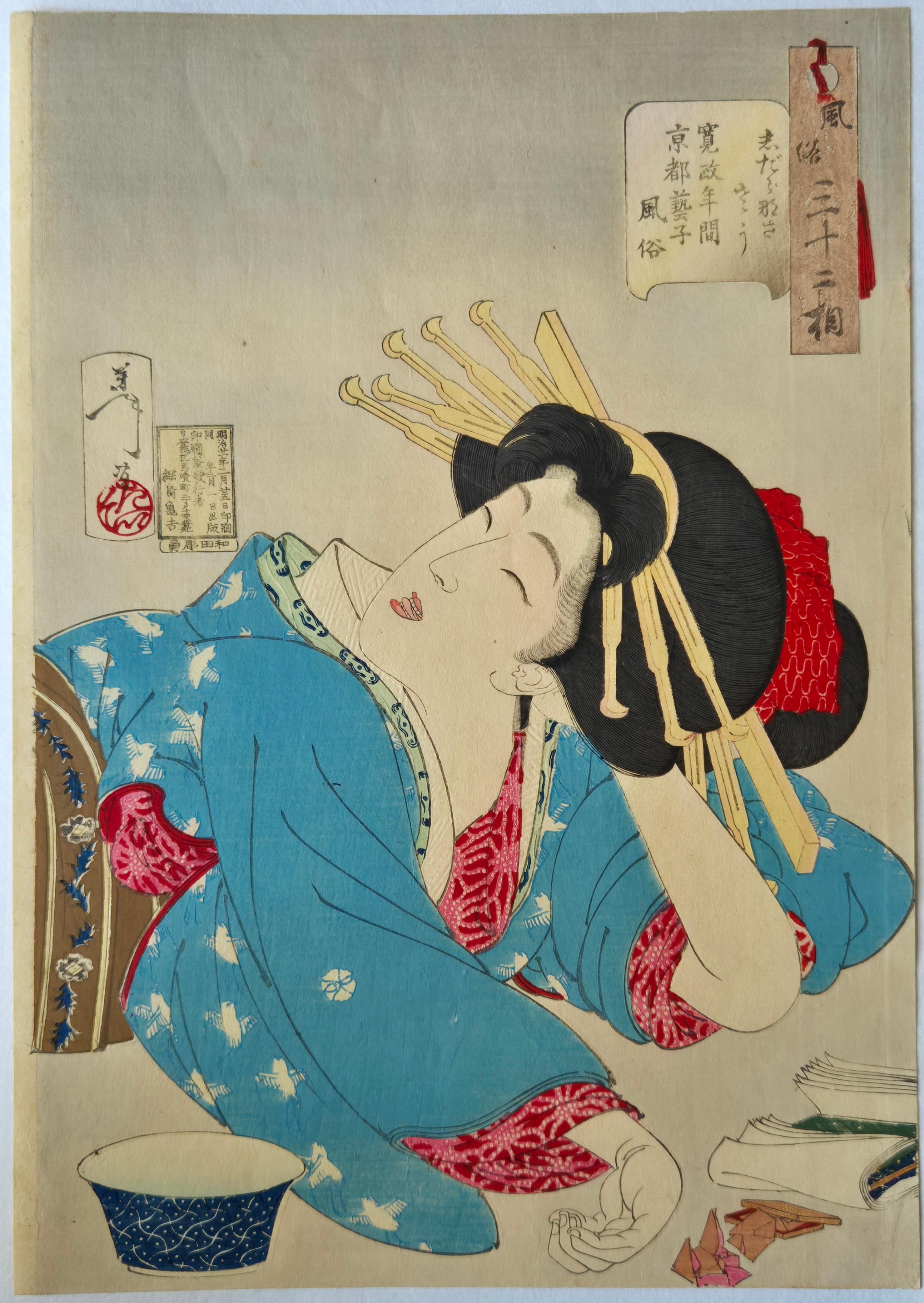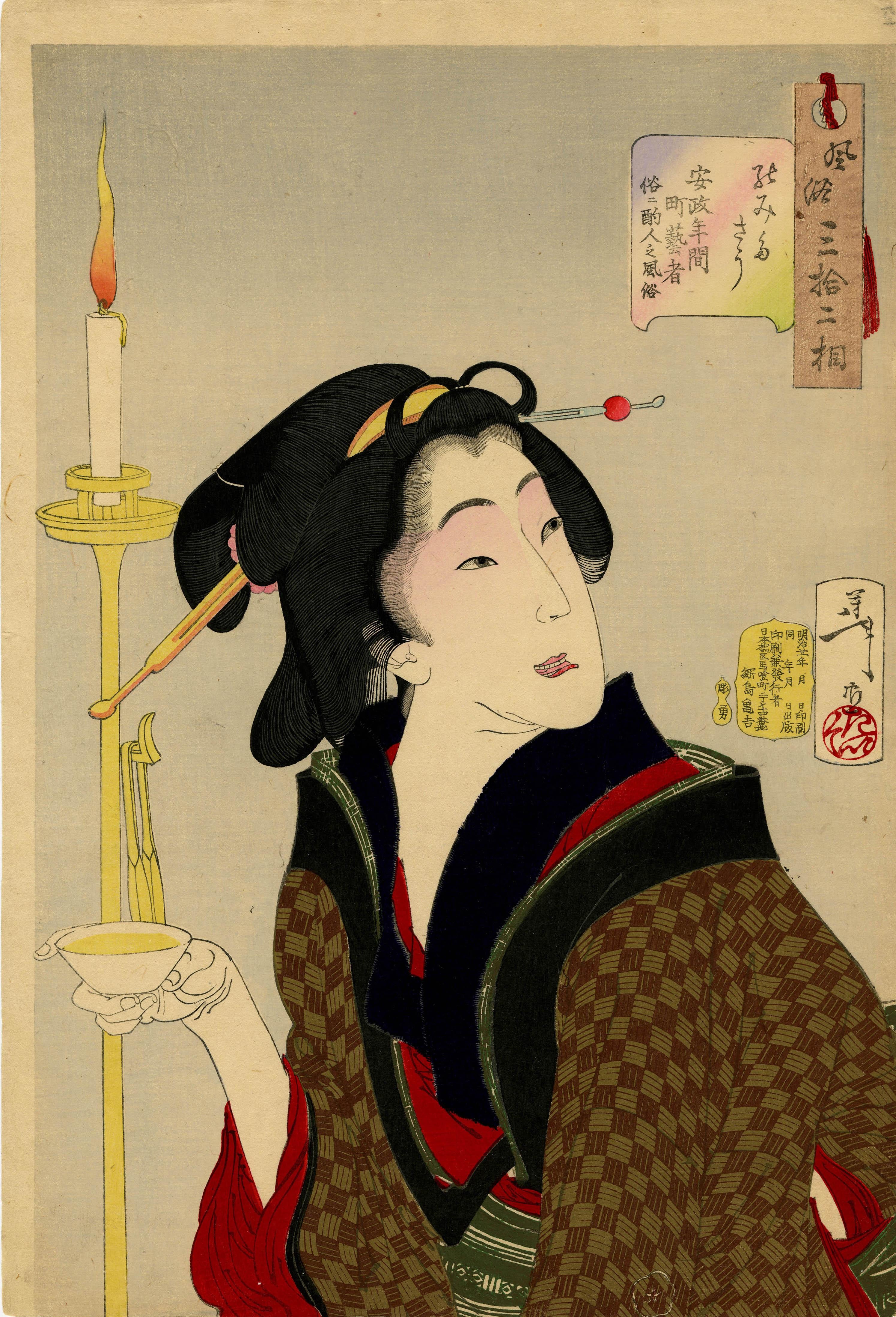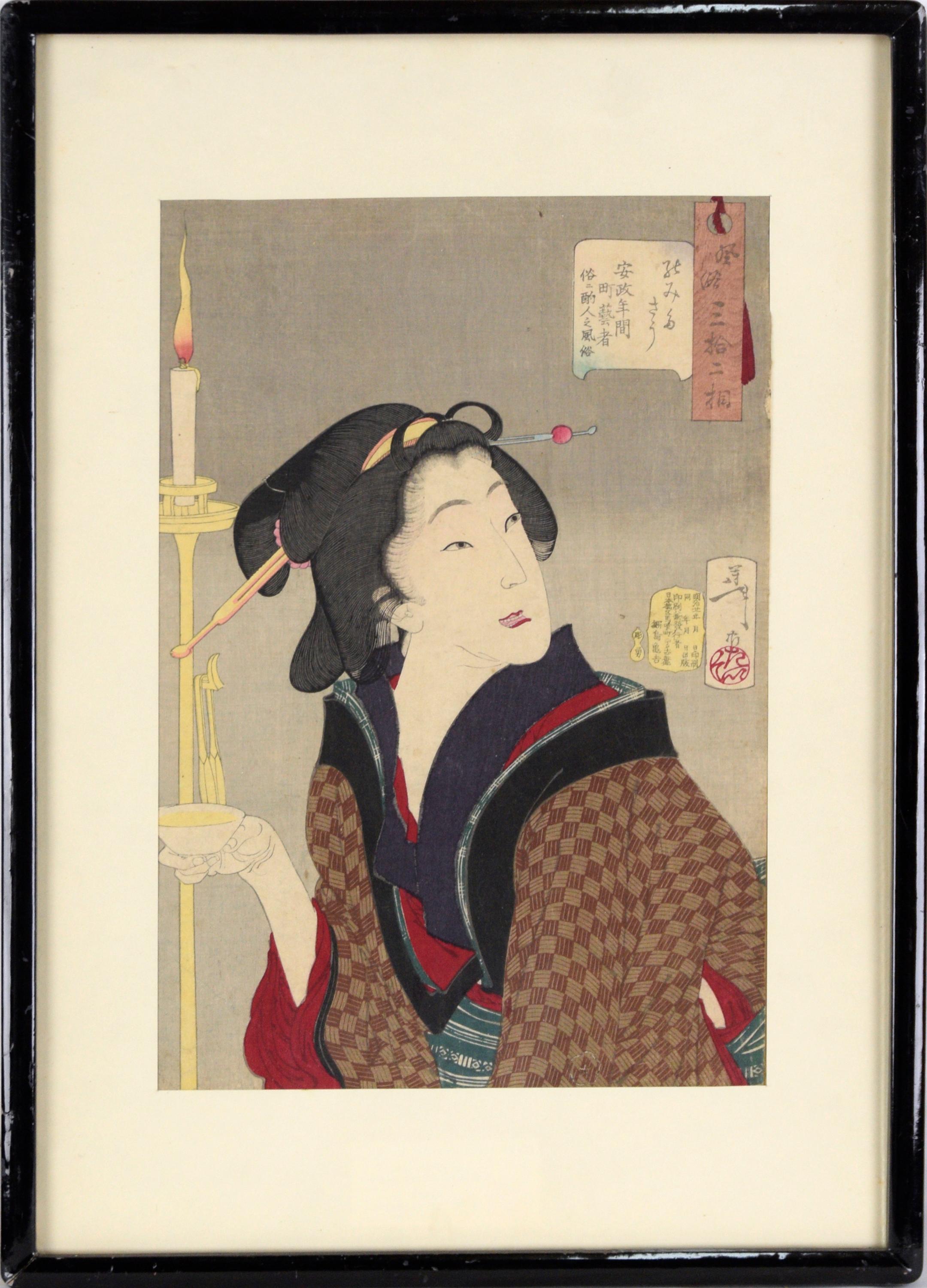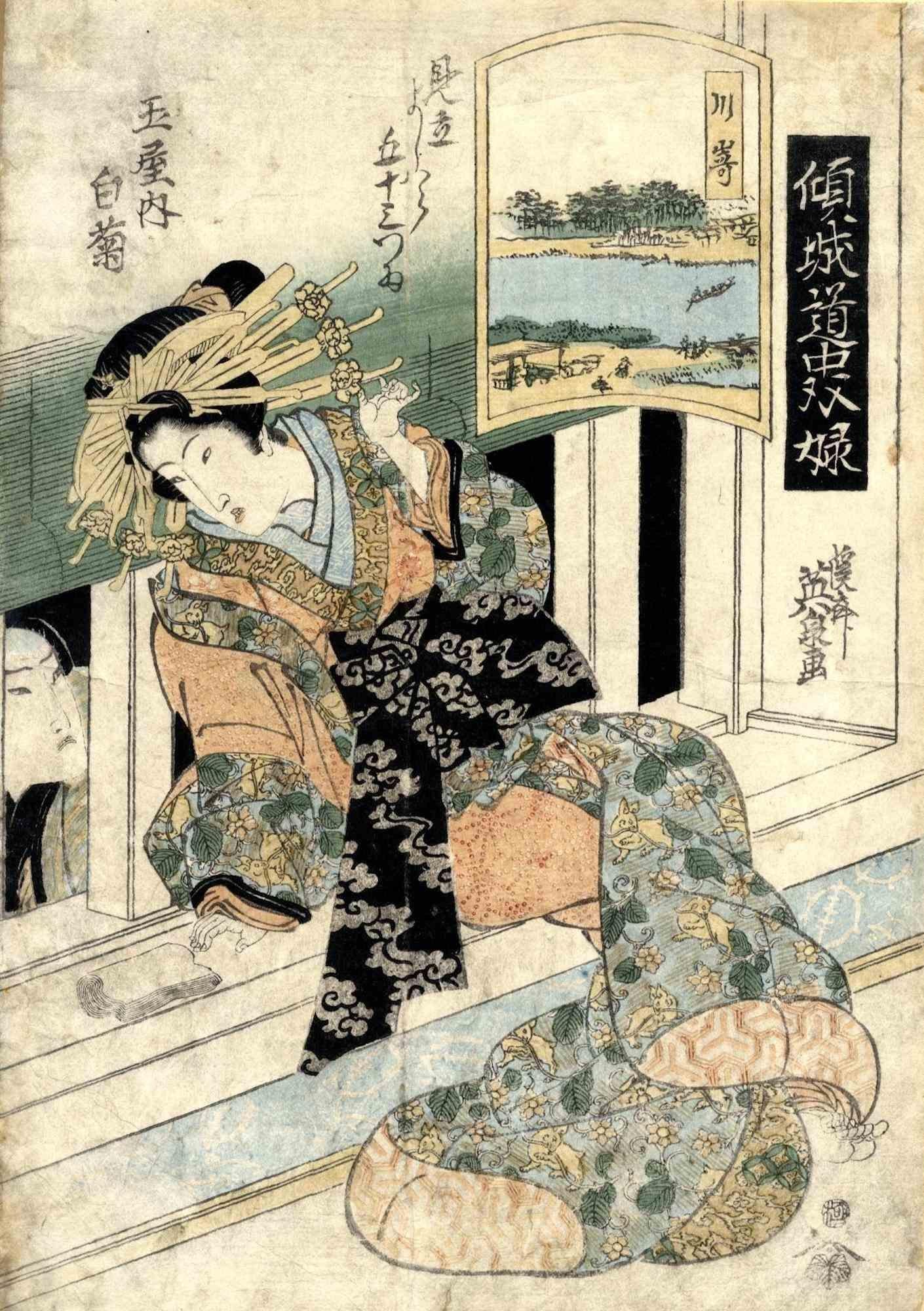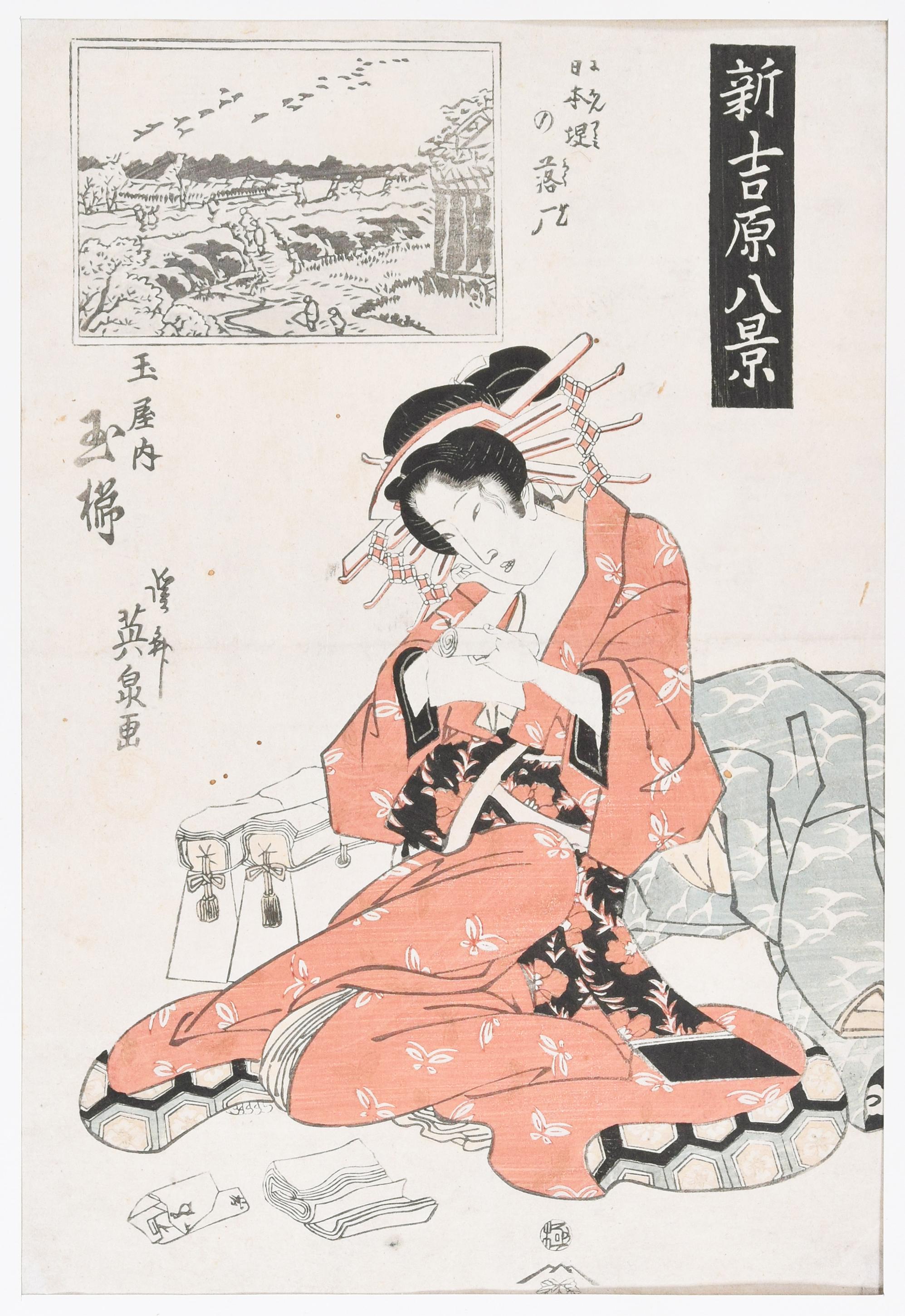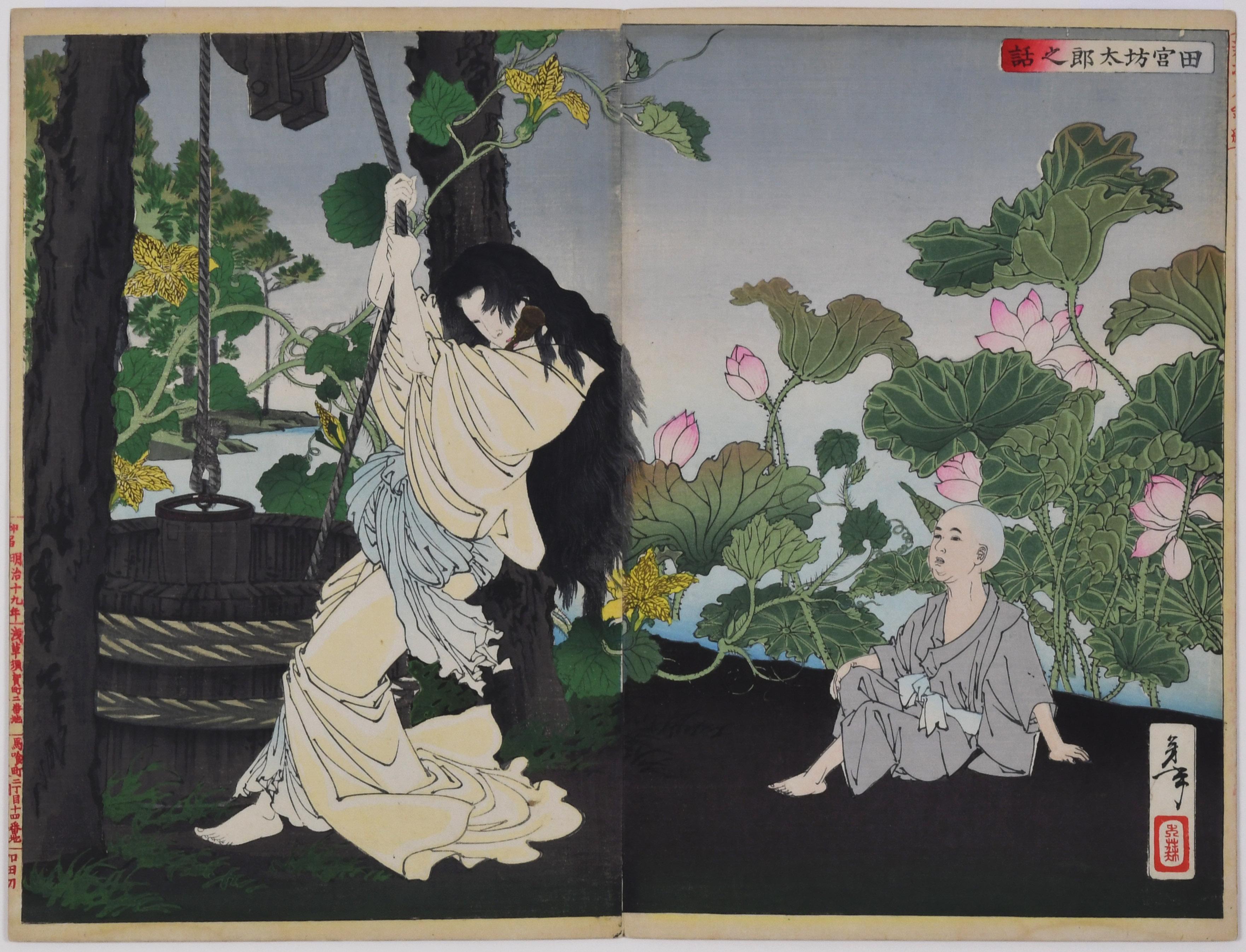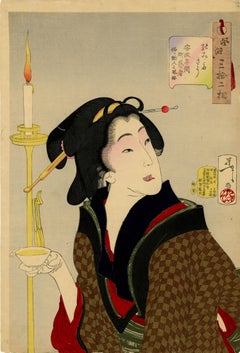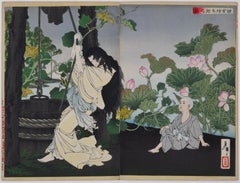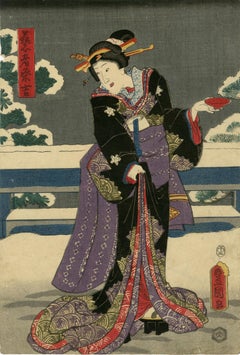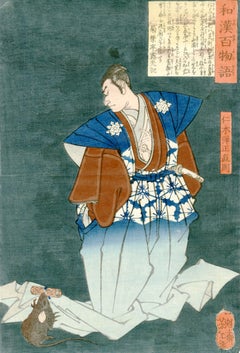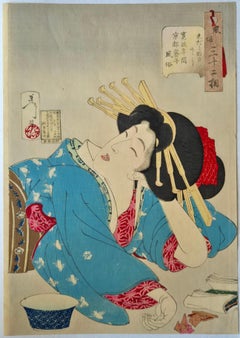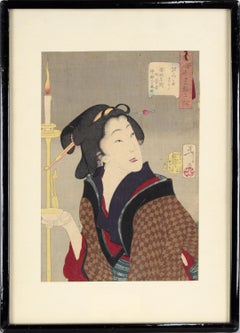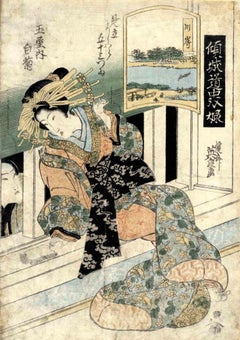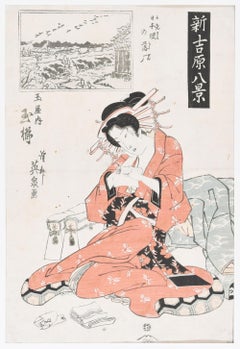Items Similar to Dangerous: The Appearance of a Contemporary Geisha of the Meiji Era
Want more images or videos?
Request additional images or videos from the seller
1 of 10
Taiso YoshitoshiDangerous: The Appearance of a Contemporary Geisha of the Meiji Era1888
1888
$2,200
£1,666.92
€1,912.66
CA$3,095.76
A$3,403.09
CHF 1,788.51
MX$41,325.87
NOK 22,311.17
SEK 21,138.26
DKK 14,274.63
About the Item
Dangerous: The Appearance of a Contemporary Geisha of the Meiji Era
Color woodcut, 1888
Plate 28 from the series "Thirty-two Aspects of Customs and Manners" (Fuzoku Sanjuniso)
Format: Oban
Publisher: Tsunashima Kamekichi
Carver: Wada Hori Yu
A first edition with tricolor cartouche
Note gauffrage on collar (light blue), and robe (purple)
Yoshitoshi's "Thirty-two Aspects" depicts women of different social classes during the previous 100 years. The Meiji Era lasted from 1867-1912
Condition: Excellent
Image size: 14 x 9 5/8 inches
Sheet size: 14 5/8 x 10 1/8 inches
Reference: Beauty and Violence 63.28
Stevenson, Yoshitoshi's Women, 1986, No. 28, pp. 84-85, reproduced in color
TAISO YOSHITOSHI
(1839-1892)
Taiso Yoshitoshi was born in the city of Edo (now Tokyo) just before Japan’s violent transformation from a medieval to a modern society. In the mid 19th century pressures from the United States and Europe brought an end to Japan’s two hundred years of self-imposed isolation. In 1868 a pivotal period began known as the Meiji Restoration. It was marked by the return of Imperial power, heightened militarism, a new constitution and industrial advancement, as well as social and political reform. In the midst of shifting values, woodblock print artists like Yoshitoshi struggled to create images that would satisfy the public’s changing tastes.
During the Edo period (1600-1868) woodblock prints, or Ukiyo-e (literally “pictures of the floating world”), became one of the most popular and inexpensive visual art forms in Japan. Published in the cities, visitors bought them as souvenirs and gifts from markets and street peddlers and returned with them to remote villages. From the time the first monochrome prints were published in the 1600s, Ukiyo-e represented a unique collaboration between the publisher, the artists and the public. The rising or diminishing interests of the urban merchant class largely dictated the choice of subject matter in woodblock prints.
Yoshitoshi’s confrontation with the savagery and violence of his times, especially early on in his career, was exorcised through a prolific and bloody series of prints depicting battling warriors, demons and murderers. Later in his career, however, Yoshitoshi’s work took on a distinctive stylistic change. By the 1880s, he was experimenting freely with western concepts of space, perspective and dissonant color combinations. His treatment of movement and facial features reflected a more studied and quiet observation of the human form and emotions. While continuing to choose native themes for his prints, Yoshitoshi’s approach to creating individualized portraits of townspeople, farmers, courtesans and warriors was innovative and groundbreaking. However, by the end of the Meiji Period (1868-1912), the increasing popularity of photography and lithography nearly eclipsed the public’s interest in woodblock prints. Yoshitoshi stood alone as the last great master of Ukiyo-e.
Biography courtesy International Folk Art
- Creator:Taiso Yoshitoshi (1839-1892, Japanese)
- Creation Year:1888
- Dimensions:Height: 14.63 in (37.17 cm)Width: 10.13 in (25.74 cm)
- Medium:
- Period:
- Condition:
- Gallery Location:Fairlawn, OH
- Reference Number:Seller: UK16991stDibs: LU14015061702
About the Seller
5.0
Recognized Seller
These prestigious sellers are industry leaders and represent the highest echelon for item quality and design.
Platinum Seller
Premium sellers with a 4.7+ rating and 24-hour response times
Established in 1978
1stDibs seller since 2013
813 sales on 1stDibs
Typical response time: <1 hour
Associations
International Fine Print Dealers Association
- ShippingRetrieving quote...Shipping from: Fairlawn, OH
- Return Policy
Authenticity Guarantee
In the unlikely event there’s an issue with an item’s authenticity, contact us within 1 year for a full refund. DetailsMoney-Back Guarantee
If your item is not as described, is damaged in transit, or does not arrive, contact us within 7 days for a full refund. Details24-Hour Cancellation
You have a 24-hour grace period in which to reconsider your purchase, with no questions asked.Vetted Professional Sellers
Our world-class sellers must adhere to strict standards for service and quality, maintaining the integrity of our listings.Price-Match Guarantee
If you find that a seller listed the same item for a lower price elsewhere, we’ll match it.Trusted Global Delivery
Our best-in-class carrier network provides specialized shipping options worldwide, including custom delivery.More From This Seller
View AllThirsty: The Appearance of a Town Geisha - a So-Called Wine-Server - in the Anse
By Taiso Yoshitoshi
Located in Fairlawn, OH
Thirsty: The Appearance of a Town Geisha - a So-Called Wine-Server - in the Ansei Era
Color woodcut, 1888
Signed; Seal: Taiso (see photo)
Plate 22 from the series "Thirty-two Aspects...
Category
1880s Showa Figurative Prints
Materials
Woodcut
The Story of Tamiya Bataro
By Taiso Yoshitoshi
Located in Fairlawn, OH
The Story of Tamiya Bataro
Color woodcut diptych, March 22, 1886
Signed and sealed by the artist (see photo) Yoshitoshi signature, Taiso seal
Series: New selection of eastern brocad...
Category
1880s Figurative Prints
Materials
Woodcut
Courtesan Kumekichi
By Utagawa Kunisada (Toyokuni III)
Located in Fairlawn, OH
Courtesan Kumekichi
Color woodblock, 1858
Kabuki Actor Iwai Kumesaburo III in the role of courtesan Kumekichi, who is standing in snow hold a red sake cup
Publisher: Ohkuniya Kinjiro...
Category
1850s Other Art Style Figurative Prints
Materials
Woodcut
Nikki Danjo (Naonon)
By Taiso Yoshitoshi
Located in Fairlawn, OH
"One of the main characters of the kabuki play Meiboku Sendai hagi (The Disputed Succession)"
Signed: Ikkaisai Yoshitoshi ga (in gourd shaped cartouche)
Format: oban
Publisher: Da...
Category
1860s Figurative Prints
Materials
Woodcut
Beauty Otami - Kabuki
By Utagawa Kunisada (Toyokuni III)
Located in Fairlawn, OH
Beauty Otami - Kabuki
Note: Kabuki actor Nakamura Matsue is in the role of courtesan otami. She is standing in front of a small tea shop in a garden.
Color woodblock, c. 1800-1810
Si...
Category
Early 1800s Portrait Prints
Materials
Woodcut
Kataoka Nizayemon(?)
By Utagawa Kunisada (Toyokuni III)
Located in Fairlawn, OH
Exceptional, brilliant impression and colors from the extremely rare 1st edition
Kataoka Nizayemon(?)
Color woodcut, 1860
From the series: "Contemporary Brocade Mirror Portraits"
Pub...
Category
1860s Portrait Prints
Materials
Woodcut
You May Also Like
Tsukioka Yoshitoshi -- Looks Slovenly', Mannerisms of a Kyoto Geisha
By Tsukioka Yoshitoshi
Located in BRUCE, ACT
Tsukioka Yoshitoshi
Looks Slovenly', Mannerisms of a Kyoto Geisha from the Kansei Period from Thirty-Two Daily Scenes (風俗三十二相), 1888
Woodblock print
Oban
The image depicts a geisha...
Category
1880s Prints and Multiples
Materials
Woodcut
"Thirsty: the appearance of a town geisha in the Ansei era" - Woodblock on Paper
By Tsukioka Yoshitoshi
Located in Soquel, CA
"Thirsty: the appearance of a town geisha in the Ansei era" - Woodblock on Paper
From the series "Thirty-two Aspects of Customs and Manners" (Fuzoku sanjuniso)
Lively woodblock of a...
Category
1880s Edo Figurative Prints
Materials
Paper, Ink, Woodcut
The High - Ranking Courtesan - Woodcut Print by Keisai Eisen - 1820s
By Keisai Eisen
Located in Roma, IT
The high-ranking courtesan Shiragiku Bijinga is an original modern artwork realized by Keisai Eisen in the 1821-23.
Woodcut Print Oban Format.
From the ...
Category
19th Century Modern Figurative Prints
Materials
Woodcut
$516 Sale Price
40% Off
The Courtesan - Original Woodblock Print by Eisen Keisai - First Half of 1800
Located in Roma, IT
The Courtesan is an original print realized between in the beginning of XIX century by Keisai Eisen
This is a mixed colored xylograph. Include passeparto...
Category
Early 19th Century Figurative Prints
Materials
Woodcut
Tsukioka Yoshitoshi -- Looking Tasty, the Appearance of a Prostitute during the
By Tsukioka Yoshitoshi
Located in BRUCE, ACT
Tsukioka Yoshitoshi
Looking Tasty, the Appearance of a Prostitute during the Kaei Era from Thirty-Two Daily Scenes (風俗三十二相), 1888
Woodblock print
Oban
This piece depicts a woman on...
Category
1880s Prints and Multiples
Materials
Woodcut
Japanese Art Ukiyo-e Figurative painting, Courtesan Hanaôgi, Edo period
Located in Segovia, ES
Bijin-ga Series XXVI (Nº 26)
Title: Hanaôgi of the Ôgiya House
Hanaôgi, one of the most famous courtesans of the Edo period working in the Ôgiya House, an exclusive brothel in the Yoshiwara appears beautifully dressed holding a writing brush on her right hand and a decorated piece of paper in the shape of a “cartuche”, maybe to write a message of love for a client.
This image is part of the bijin-ga series (“Pretty women”) drawn by Mario BGil, based in the Kitigawa Utamaro woodblock print...
Category
2010s Edo Figurative Drawings and Watercolors
Materials
Paper, Crayon, Oil Crayon, Graphite
More Ways To Browse
Antique Geisha
Frank Sinatra Hirschfeld
Grosz Interregnum
Hand Signed Norman Rockwell
Hector Julio Paride Bernabo
Henri Matisse Nadia
Henry Monnier
Henry Moore Sculptural Objects
Hirschfeld Nina
Hockney Parade
Hokusai Woodblock Prints
Horse Woman Picasso
James E Allen
Jane Scott Wooster
Japanese Woodblock Samurai
Jason Boyd Kinsella
Jason Boyd
Jean Michael Basquiat
